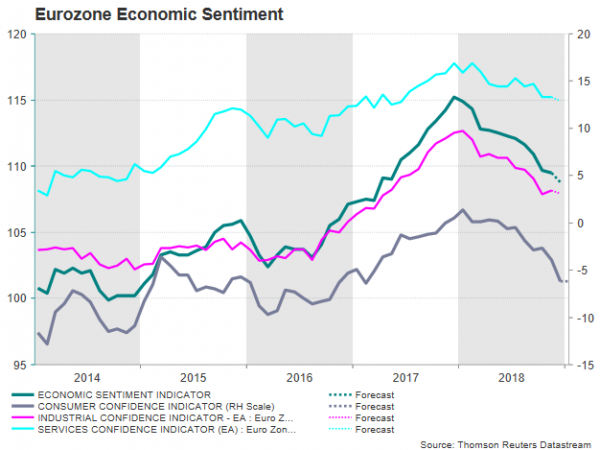The European Commission is publishing its final Business and Consumer Survey for 2018 on Tuesday at 1000 GMT. While the numbers stood at 18-year highs at the end 2017, creating euphoria that the uptrend would continue in the near future, the confidence indicators moved to the downside during 2018 and are now forecasted to finish the year even lower.
The economic sentiment index which measures confidence in five areas (industrials, services, consumers, construction, retail sales) is projected to drop by 0.7 points to 108.8 in December, registering a 5.8-point loss for 2018. The industrial and services sub-measures which hold the largest weights in the index are forecasted to decline to 3.1 and 12.9 respectively, from 3.4 and 13.3 before, while final estimates on consumer confidence are expected to confirm that consumers’ pessimism deteriorated to two-year lows.
Another discouraging data set would muddy the already clouded growth outlook for the euro area in the fourth quarter and feed fears that the bloc’s weakening economic performance in 2018 could stretch into 2019. Indeed, if a hard Brexit occurs in March and trade talks between the US and the rest of the world remain in the dark, the eurozone will likely move down another gear, with Italy struggling the most as the government will be fighting to deliver its revised spending plans in a risky euro environment. Falling economic activity in France could also bring more damage to Macron’s administration which already faces the anger of the public because of its policy tactics.
On the monetary front, a disappointing survey on Tuesday would give more reasons to the European Central Bank to continue supporting the bloc after terminating its three-year asset purchasing program last month. Friday’s flash core CPI figure showed that the ECB failed to push up inflation this year, adding to the growing evidence that the economy is facing headwinds that don’t allow inflationary pressures to strengthen. Hence as the central bank cannot lower its already ultra-low interest rates, while bringing QE back into play would harm its credibility, reinvesting maturing bonds will likely be the main tool to boost liquidity until the first rate hike and as long as it’s needed according to ECB.
In FX markets, EURUSD may retest the area around the 50-period simple moving average, currently at 1.1415, if economic confidence shrunk faster than analysts forecast, raising a warning flag for growth outlook. Breaking below that zone, the pair could fall towards 1.1350 where some support was identified during December, while if this fails to hold, then the next stop could be between 1.1275 and 1.1266.
Alternatively, and in the absence of any important headlines, better-than-expected results could shift some funds into the euro, driving the pair up to the 1.1475 resistance. Higher, the bulls may pause around the 1.1500 peak before hitting 1.1550.
